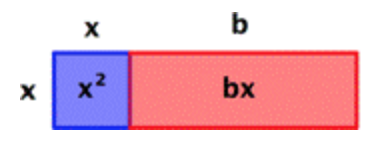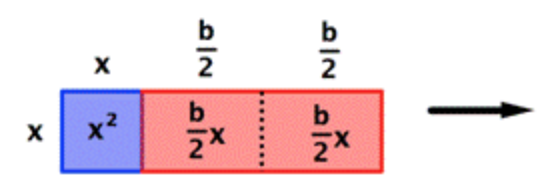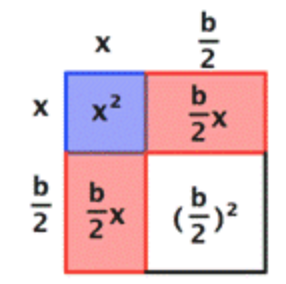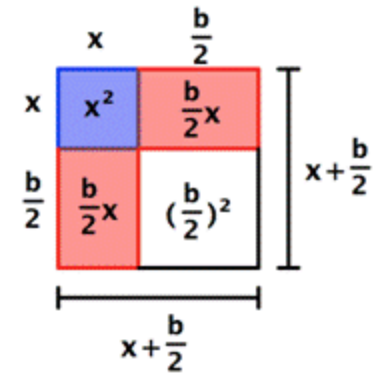
`x(x+b)=x^2+bx`
Square Roots and Completing the Square
Quadratic equations can be solved in many ways. You may already be familiar with factoring to solve some quadratic equations. However, not all quadratic equations can be factored. In this topic, you will use square roots to learn another way to solve quadratic equations, and this method will work with all quadratic equations.
One way to solve the quadratic equation `x^2 = 9` is to subtract `9` from both sides to get one side equal to `0`: `x^2 - 9 = 0`. The expression on the left can be factored:
`(x + 3)(x - 3) = 0`. Using the zero factor property, you know this means `x + 3 = 0` or `x - 3 = 0`, so `x = -3` or `3`.
Another property would let you solve that equation more easily.
|
The Square Root Property If `x^2 = a^2`, then `x = a` or `x = -a`.
If `x^2 = a`, then `x=sqrta` or `-sqrta`.
The property above says that you can take the square root of both sides of an equation, but you have to think about two cases: the positive square root of `a` and the negative square root of `a`.
|
A shortcut way to write “`sqrta`” or “`-sqrta`” is “`+-sqrta`”. The symbol `+-` is often read “positive or negative.” If it is used as an operation (addition or subtraction), it is read “plus or minus.”
|
Example |
||
|
Problem |
Solve using the Square Root Property. `x^2 = 9` |
|
|
|
`x^2 = 9` `x=+-sqrt9` `x=+-3` |
Since one side is simply `x^2`, you can take the square root of both sides to get `x` on one side. Don’t forget to use both positive and negative square roots! |
|
Answer |
`x=+-3` (that is, `x = 3` or `-3`) |
|
Notice that there is a difference here in solving `x^2 = 9` and finding `sqrt9`. For `x^2 = 9`, you are looking for all numbers whose square is `9`. For `sqrt9`, you only want the principal (nonnegative) square root. The negative of the principal square root is `-sqrt9`; both would be `+-sqrt9`. Unless there is a symbol in front of the radical sign, only the nonnegative value is wanted!
In the example above, you can take the square root of both sides easily because there is only one term on each side. In some equations, you may need to do some work to get the equation in this form. You will find that this involves isolating `x^2`.
|
Example |
|||||||||||||||||
|
Problem |
Solve. `10x^2 + 5 = 85` |
|
|||||||||||||||
|
|
`10x^2 + 5 = 85`
|
If you try taking the square root of both sides of the original equation, you will have `sqrt(10x^2+5)` on the left, and you can’t simplify that. Subtract `5` from both sides to get the `x^2` term by itself. |
|||||||||||||||
|
|
`10x^2 = 80`
|
You could now take the square root of both sides, but you would have `sqrt10` as a coefficient, and you would need to divide by that coefficient. Dividing by `10` before you take the square root will be a little easier. |
|||||||||||||||
|
|
|
Now you have only `x^2` on the left, so you can use the Square Root Property easily.
Be sure to simplify the radical if possible.
|
|||||||||||||||
|
Answer |
`x=+-2sqrt2` |
|
|||||||||||||||
Sometimes more than just the `x` is being squared:
|
Example |
||||||||||||||
|
Problem |
Solve. `(x - 2)^2 - 50 = 0` |
|
||||||||||||
|
|
`(x - 2)^2 - 50 = 0` |
Again, taking the square root of both sides at this stage will leave something you can’t work with on the left. Start by adding `50` to both sides. |
||||||||||||
|
|
`(x-2)^2=50` `x-2=+-sqrt50` |
Because `(x - 2)^2` is a squared quantity, you can take the square root of both sides. |
||||||||||||
|
|
|
To isolate `x` on the left, you need to add `2` to both sides.
Be sure to simplify the radical if possible.
|
||||||||||||
|
Answer |
`x=2+-5sqrt2` |
|
||||||||||||
This method can be helpful when solving real-world problems.
|
Example |
|||||||||||
|
Problem |
The formula for compounding interest annually is `A=P(1 + r)^t`, where `A` is the balance after `t` years, when `P` is the principal (initial amount invested) and `r` is the interest rate. Find the interest rate `r` if `$3,000` is invested and grows to `$3,307.50` after `2` years. |
||||||||||
|
|
`A=P(1 + r)^t` `A = 3,307.50` `t = 2` `P = 3,000` |
First, identify what you know. The amount after `2` years is `3,307.50`, so `A = 3,307.50`. This also means `t = 2`. The principal `P` is the original amount invested, so that is `3,000`. |
|||||||||
|
|
`3,307.50 = 3,000(1 + r)^2` |
Substitute the values for the variables you know. Only `r` is left, so try to isolate `r`. |
|||||||||
|
|
|
Dividing both sides by `3,000` leaves only `(1 + r)^2` on the right. Because `(1 + r)^2` is a squared quantity, you can use the Square Root Property.
Don’t forget the `+-`! |
|||||||||
|
|
`+-1.05 = 1 + r` |
Using a calculator, you can find that `sqrt(1.1025)` is `1.05`. |
|||||||||
|
|
`+-1.05 - 1 = r` |
Subtract `1` from both sides to isolate `r` on the right. |
|||||||||
|
|
`1.05 - 1 = r` or `-1.05-1=r` |
You now have two equations, one using `1.05` and one using `-1.05`. |
|||||||||
|
|
`r = 0.05` or `-2.05` |
Simplifying the two equations gives two solutions to the equation. |
|||||||||
|
Answer |
The interest rate is `0.05` or `5%`
|
Notice that a negative interest rate doesn’t make sense for this context, so only the positive value could be the interest rate. The `-2.05` is an extraneous solution and must be discarded. |
|||||||||
|
Solve. `(x - 3)^2 - 2 = 16`
A) `x = 3 +-3sqrt2`
B) `x = 3 + 3sqrt2`
C) `x = 7`
D) `x = 1` or `9`
|
Of course, quadratic equations often will not come in the format of the examples above. Most of them will have `x` terms. However, you may be able to factor the expression into a squared binomial, and, if not, you can still use squared binomials to help you.
First, let’s consider squared binomials. Some of the above examples have squared binomials: `(1 + r)^2` and `(x - 2)^2` are squared binomials. (They are binomials, two terms, that are squared.) If you expand these, you get a perfect square trinomialA trinomial that is the product of a binomial times itself, such as `a^2 + 2ab + b^2` (from `(a + b)^2)`, and `a^2 - 2ab + b^2` (from `(a - b)^2)`. . For example, `(1 + r)^2 = (1 + r)(1 + r) = 1 + 2r + r^2`, or `r^2 + 2r + 1`. The trinomial `r^2 + 2r + 1` is a perfect square trinomial. Notice that the first and last terms are squares (`r^2` and `1`). The middle term is twice the product of the square roots of the first and last terms, the square roots are `r` and `1`, and the middle term is `2(r)(1)`.
Perfect square trinomials have the form `r^2 + 2rs + s^2` and can be factored as `(r + s)^2`, or they have the form `r^2 - 2rs + s^2` and can be factored as `(r - s)^2`. Let’s factor a perfect square trinomial into a squared binomial.
|
Example |
||
|
Problem |
Factor `9x^2 - 24x + 16`. |
|
|
|
`9x^2 = (3x)^2` `16 = 4^2` |
First, notice that the `x^2` term and the constant term are both perfect squares. |
|
|
`24x = 2(3x)(4)`
|
Then notice that the middle term (ignoring the sign) is twice the product of the square roots of the other terms. |
|
|
`r = 3x` `s = 4`
`9x^2 - 24x + 16 = (3x - 4)^2` |
A trinomial in the form `r^2 - 2rs + s^2` can be factored as `(r - s)^2`.
In this case, the middle term is subtracted, so subtract `r` and `s` and square it to get `(r - s)^2`. |
|
Answer |
`(3x - 4)^2` |
|
You can use the procedure in this next example to help you solve equations where you identify perfect square trinomials, even if the equation is not set equal to `0`.
|
Example |
|||||||||||
|
Problem |
Solve. `4x^2 + 20x + 25 = 8` |
|
|||||||||
|
|
`4x^2 + 20x + 25 = 8`
|
Since there’s an `x` term, you can’t use the Square Root Property immediately (or even after adding or dividing by a constant).
Notice, however, that the `x^2` and constant terms on the left are both perfect squares: `(2x)^2` and `5^2`. Check the middle term: is it `2(2x)(5)`? Yes! |
|||||||||
|
|
`(2x + 5)^2 = 8`
|
A trinomial in the form `r^2 + 2rs + s^2` can be factored as `(r + s)^2`, so rewrite the left side as a squared binomial. |
|||||||||
|
|
|
Now you can use the Square Root Property. Some additional steps are needed to isolate. |
|||||||||
|
|
|
Simplify the radical when possible. |
|||||||||
|
Answer |
`x=-5/2+-sqrt2` |
|
|||||||||
You may have looked at the problem above and thought, “Why not subtract `8` from both sides first, making the equation `4x^2 + 20x + 17 = 0`?” This is one technique for solving for `x`. The problem is that, even if you did this, the equation `4x^2 + 20x + 17 = 0` cannot be factored with real numbers. (Try it. Can you think of two numbers whose product is `68` and whose sum is `20`?)
Since the expression `4x^2 + 20x + 25` can be identified as a perfect square trinomial, it is best to factor it as `(2x + 5)^2` and then use the Square Root Property.
One way to solve quadratic equations is by completing the squareA method for solving quadratic equations by rewriting one side of the equation as a squared binomial.. When you don’t have a perfect square trinomial, you can create one by adding a constant term that is a perfect square to both sides of the equation. Let’s see how to find that constant term.
“Completing the square” does exactly what it says: it takes something that is not a square and makes it one. This idea can be illustrated using an area model of the binomial `x^2 + bx`.
 |
`x(x+b)=x^2+bx` |
In this example, the area of the overall rectangle is given by `x(x + b)`.
Now let's make this rectangle into a square. First, divide the red rectangle with area `bx` into two equal rectangles each with area `b/2x` . Then rotate and reposition one of them. You haven't changed the size of the red area; it still adds up to `bx`.
 |
 |
`x^2+2(b/2)x+(b/2)^2` |
The red rectangles now make up two sides of a square, shown in white. The area of that square is the length of the red rectangles squared, or `(b/2)^2`.
Here comes the cool part: when the white square is added to the blue and red regions, the whole shape is also now a square. In other words, you've “completed the square!” By adding the quantity `(b/2)^2` to the original binomial, you've made a square, a square with sides of `x+b/2`.
 |
`x^2+bx+(b/2)^2=x^2+2(b/2)x+(b/2)^2=(x+b/2)^2` |
Notice that the area of this square can be written as a squared binomial: `(x+b/2)^2`.
|
Finding a Value that will Complete the Square in an Expression
To complete the square for an expression of the form `x^2 + bx`:
The expression becomes `x^2+bx+(b/2)^2=(x+b/2)^2`.
|
|
Example |
|||
|
Problem |
Find the number to add to `x^2 + 8x` to make it a perfect square trinomial. |
||
|
|
`x^2 + 8x` `b = 8` |
|
First, identify `b` if this has the form `x^2 + bx`. |
|
|
`x^2+8x+(8/2)^2` |
|
To complete the square, add `(b/2)^2`.
`b = 8`, so `(b/2)^2=(8/2)^2` |
|
|
`x^2 + 8x + (4)^2` `x^2 + 8x + 16`
`x^2 + 8x + 16 = (x + 4)^2` |
|
Simplify.
Check that the result is a perfect square trinomial. `(x + 4)^2=x^2+4x+4x+16=x^2+8x+16` It is!
|
|
Answer |
Adding `+16` will make `x^2 + 8x` a perfect square trinomial. |
||
Notice that `(b/2)^2` is always positive, since it is the square of a number. When you complete the square, you are always adding a positive value.
|
Use completing the square to find the value to add that makes `x^2 - 12x` a perfect square trinomial. Then write the expression as the square of a binomial.
A) Add `12`. `(x - 6)^2`
B) Add `36`. `(x + 6)^2`
C) Add `-12`. `(x - 12)^2`
D) Add `36`. `(x - 6)^2`
|
You can use completing the square to help you solve a quadratic equation that cannot be solved by factoring.
Let’s start by seeing what happens when you complete the square in an equation. In the example below, notice that completing the square will result in adding a number to both sides of the equation. You have to do this in order to keep both sides equal!
|
Example |
|||
|
Problem |
Rewrite `x^2 + 6x = 8` so that the left side is a perfect square trinomial. |
||
|
|
`x^2 + 6x = 8` `b = 6` |
|
This equation has a constant of `8`. Ignore it for now and focus on the `x^2` and `x` terms on the left side of the equation. The left side has the form `x^2 + bx`, so you can identify `b`. |
|
|
`x^2 + 6x+9=8+9` |
|
To complete the square, add `(b/2)^2` to the left side.
`b = 6`, so `(b/2)^2=(6/2)^2=3^2=9`
This is an equation, though, so you must add the same number to the right side as well.
|
|
|
`x^2 + 6x + 9 = 17`
`x^2 + 6x + 9 = 17` `(x + 3)^2 = 17` |
|
Simplify.
Check that the left side is a perfect square trinomial. `(x + 3)^2=x^2+3x+3x+9=x^2+6x+9` It is!
|
|
Answer |
`x^2 + 6x + 9 = 17` |
|
|
Can you see that completing the square in an equation is very similar to completing the square in an expression? The main difference is that you have to add the new number (`+9` in this case) to both sides of the equation to maintain equality.
Now let’s look at an example where you are using completing the square to actually solve an equation, finding a value for the variable.
|
Example |
|||||||||||||
|
Problem |
Solve. `x^2 - 12x - 4 = 0` |
|
|||||||||||
|
|
`x^2 - 12x = 4` `b = -12`
|
|
Since you cannot factor the trinomial on the left side, you will use completing the square to solve the equation.
Rewrite the equation with the left side in the form |
||||||||||
|
|
`x^2 - 12x+36=4+36`
`x^2 - 12x + 36 = 40` |
|
Figure out what value to add to complete the square. Add `(b/2)^2` to complete the square, so: `(b/2)^2=((-12)/2)^2=(-6)^2=36`
Add the value to both sides of the equation and simplify. |
||||||||||
|
|
`(x - 6)^2 = 40`
|
|
Rewrite the left side as a squared binomial. |
||||||||||
|
|
`x-6=+-sqrt40`
|
|
Use the Square Root Property. Remember to include both the positive and negative square root, or you’ll miss one of the solutions. |
||||||||||
|
|
|
|
Solve for `x` by adding `6` to both sides. Simplify as needed.
|
||||||||||
|
Answer |
`x=6+-2sqrt10` |
|
|||||||||||
You may have noticed that because you have to use both square roots, all the examples have two solutions. Here is another example that’s slightly different.
|
Example |
|||
|
Problem |
Solve. `x^2 + 16x + 17 = -47` |
||
|
|
`x^2 + 16x = -64` `b = 16` |
|
Rewrite the equation so the left side has the form `x^2 + bx`. Identify `b`. |
|
|
`x^2 + 16x + 64 = -64 + 64` `x^2 + 16x + 64 = 0` |
|
Add `(b/2)^2`, which is `(16/2)^2=8^2=64`, to both sides. |
|
|
`(x + 8)^2 = 0` |
|
Write the left side as a squared binomial. |
|
|
`x + 8 = 0`
|
|
Take the square roots of both sides. Normally both positive and negative square roots are needed, but `0` is neither positive nor negative. `0` has only one root. |
|
|
`x = -8` |
|
Solve for `x`. |
|
Answer |
`x=-8` |
|
|
Take a closer look at this problem and you may see something familiar. Instead of completing the square, try adding `47` to both sides in the equation. The equation `x^2 + 16x + 17 = -47` becomes `x^2 + 16x + 64 = 0`. Can you factor this equation using grouping? (Think of two numbers whose product is `64` and whose sum is `16`).
It can be factored as `(x + 8)(x + 8) = 0`, of course! Knowing how to complete the square is very helpful, but it is not always the only way to solve an equation.
|
Solve. `x^2 - 16x = -1`
A) `x=4+-sqrt15`
B) `x=-8+-3sqrt7`
C) `x=8+-i`
D) `x=8+-3sqrt7`
|
Completing the square is used to change a binomial of the form `x^2 + bx` into a perfect square trinomial `x^2+bx+(b/2)^2`, which can be factored to `(x+b/2)^2`. When solving quadratic equations by completing the square, be careful to add `(b/2)^2` to both sides of the equation to maintain equality. The Square Root Property can then be used to solve for `x`. With the Square Root Property, be careful to include both the principal square root and its opposite. Be sure to simplify as needed.